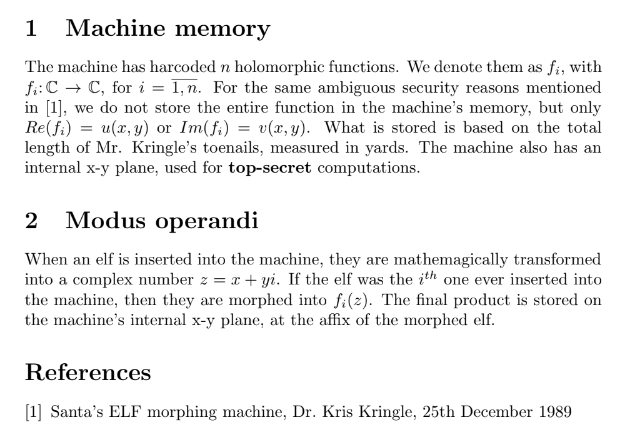Brief
Santa’s ELF holomorphing machine was a programming challenge described by the following brief:

We’re also given a text file with about 800 functions and complex numbers, as follows:
1
2
3
4
5
6
u = -3 * x + 95 * y; z = -0.12652202789462033 + 0.006530883329643569 * i
v = -65 * x + 5 * y; z = -0.16588235294117648 + 0.04352941176470588 * i
u = 55 * x + -93 * y; z = 0.09379818399862944 + 0.023213979784135686 * i
u = 71 * x + -26 * y; z = 0.09060696169319574 + 0.09358054923911142 * i
v = 78 * x + -38 * y; z = -0.01487778958554729 + -0.056854410201912856 * i
...
Objective
After reading the brief, it looks like we need to find some function \(f_i\) for each given complex number \(z_i\), and then plot the points on a normal x-y plane. At this point I wasn’t sure what a holomorphic function was, so I did some reading and found that it has to do with complex differentiation - which wasn’t very helpful. However, all holomorphic functions have the following property:
If a complex function \(f(x + iy) = u(x ,y) + iv(x, y)\) is holomorphic, then \(u\) and \(v\) have first partial derivatives with respect to \(x\) and \(y\), and satisfy the Cauchy-Riemann equation:
\begin{equation} \frac{\partial u}{\partial x} = \frac{\partial v}{\partial y}, \frac{\partial u}{\partial y} = -\frac{\partial v}{\partial x} \end{equation}
Since we’re provided with either \(u\) or \(v\), we can use the above equation to work out the other corresponding part, and join it to have \(f_i(x + iy) = u(x ,y) + iv(x, y)\) for each \(z_i\). As an example, \(u = -3 * x + 95 * y;\) has the following partial derivatives:
\begin{equation} \frac{\partial u}{\partial x} = -3, \frac{\partial u}{\partial y} = 95, \end{equation}
So by the Cauchy-Riemann equation, we have:
\begin{equation} \frac{\partial v}{\partial y} = -3, -\frac{\partial v}{\partial x} = 95, \end{equation}
Piecing it together
We can piece this together to find that \(v = (-95) * x + (-3) * y\). We’d then send \(z_i\) to the new \(f_i(x + iy) = u(x ,y) + iv(x, y)\) for each \(i\) and plot the corresponding (x,y) points. I wrote the following code to do this:
1
2
3
4
5
6
7
8
9
10
11
12
13
14
15
16
17
18
19
20
21
22
23
24
25
26
27
28
29
30
31
32
33
34
35
36
37
38
39
40
41
42
43
44
45
46
47
48
#!/usr/bin/python3
from pylab import *
xpoints = []
ypoints = []
lines = open("holoinput.txt").read().split('\n')
for line in lines:
if line.startswith("u"):
u = line.split(';')[0] #get just the u = ax + by
ua = u.split(' ')[2] #get just a
ub = u.split(' ')[6] #get just b
va = float(ub)*(-1) #v = -bx + ay
vb = float(ua) #v = -bx + ay
#now we need to send in z into u and v, to get f(z)
z = line.split(';')[1] #just get z = a + bi
za = z.split(' ')[3] #we just need the a from z = a + bi
zb = z.split(' ')[5] #we just need the b from z = a + bi
#work out u(za,zb)
uz = float(ua) * float(za) + float(ub) * float(zb)
#work out v(za,zb)
vz = float(va) * float(za) + float(vb) * float(zb)
#the affix is (u(za,zb), v(za,zb))
print("(" + str(uz) + ", " + str(vz) + ")")
xpoints.append(uz)
ypoints.append(-vz) #need to flip all points about the y-axis
#do the same as above, but with the v functions
if line.startswith("v"):
v = line.split(';')[0]
va = v.split(' ')[2]
vb = v.split(' ')[6]
ua = float(vb)
ub = float(va)*(-1)
z = line.split(';')[1]
za = z.split(' ')[3]
zb = z.split(' ')[5]
uz = float(ua) * float(za) + float(ub) * float(zb)
vz = float(va) * float(za) + float(vb) * float(zb)
print("(" + str(uz) + ", " + str(vz) + ")")
xpoints.append(uz)
ypoints.append(-vz) #need to flip all points about the y-axis
scatter(xpoints, ypoints, marker='.')
show()
After running the program, I found that we needed to flip the resulting scatter plot about the y-axis, which is why we have ypoints.append(-vz). The resulting scatter plot is the flag:

Thanks to @HTSP and the author for a fun challenge :)
